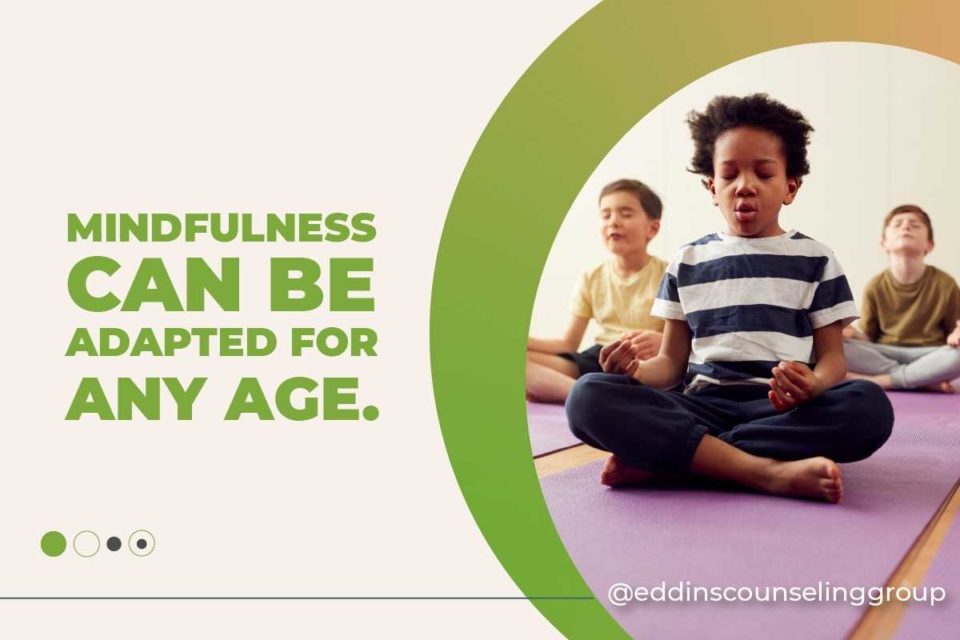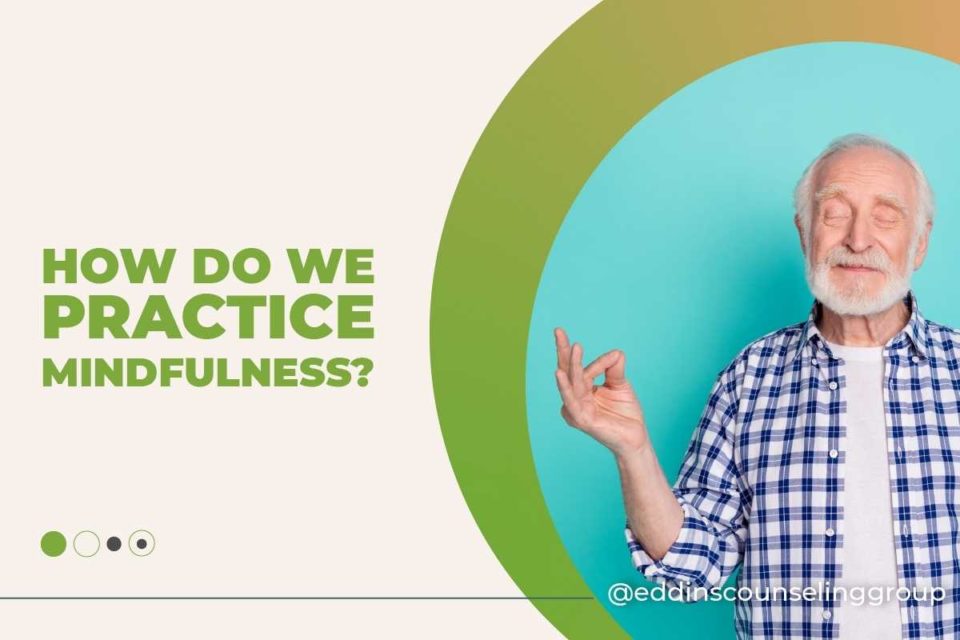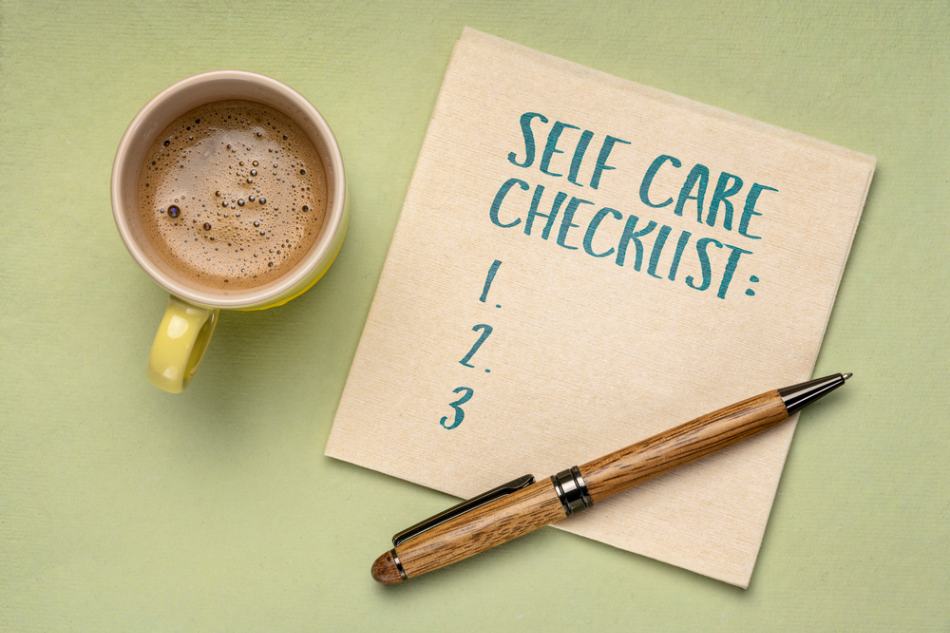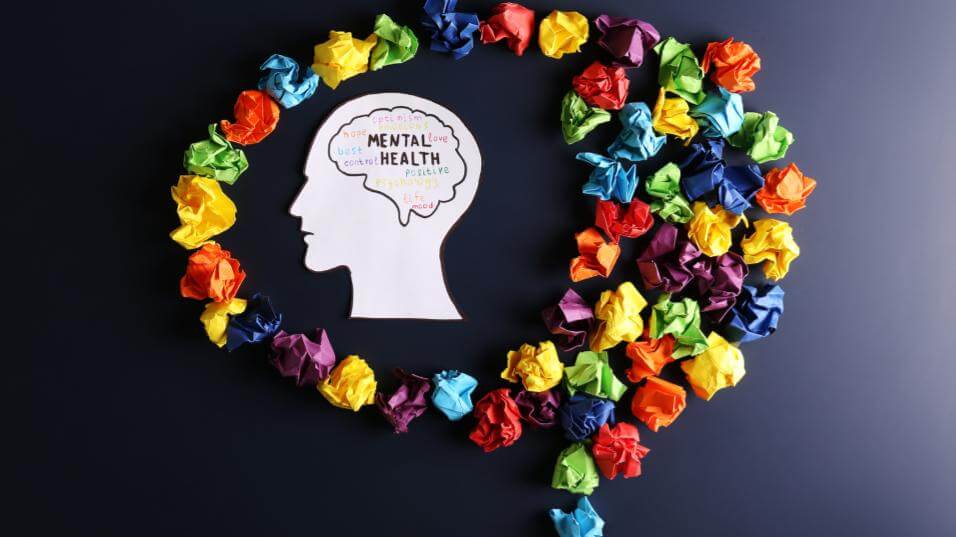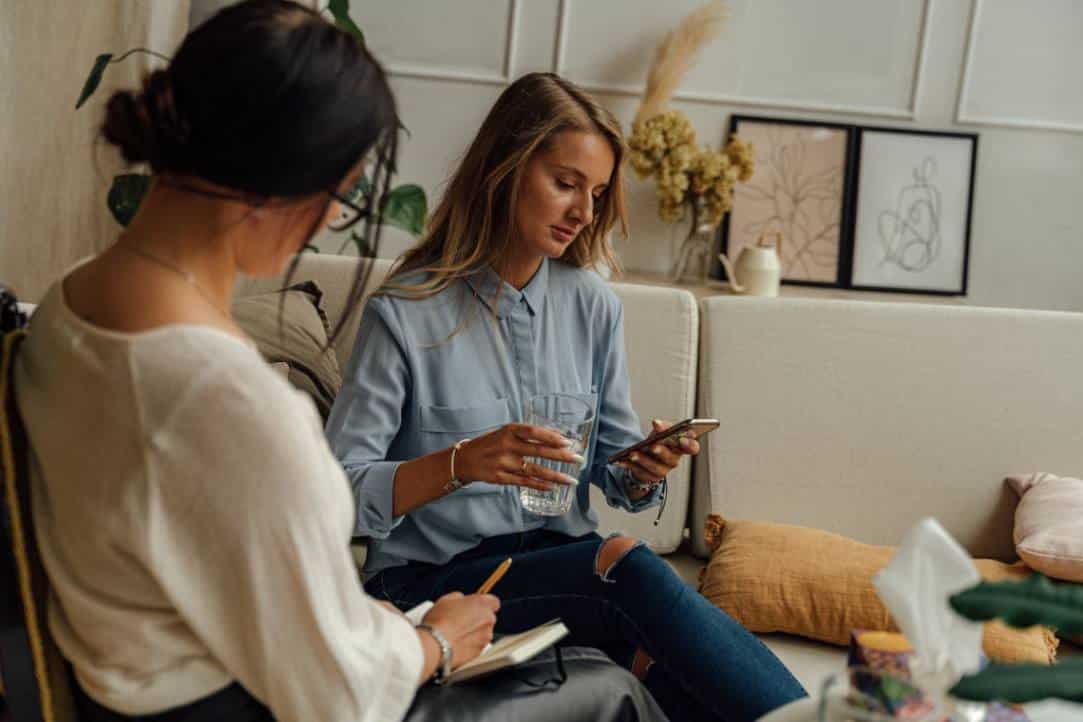March 10, 2022
Webinar: A Focus on Mindfulness
Written by Rachel Eddins
Posted in Self Help / Personal Development, Webinars and with tags: meditation, mindfulness, stress management

Develop skills to accept thoughts and urges without criticizing or impulsively acting on them. Learn to stay in the present moment without ruminating on the past or worrying about the future.
Facilitated by Tiara Runyon, LMSW
Watch a replay of this presentation here
Learn more about our stress management services and mindfulness based therapy.
Find more mindfulness resources here.
Here is a transcript of the webinar:
What is Mindfulness?
According to the Oxford dictionary, mindfulness is a mental state achieved by focusing one’s awareness on the present moment while calmly acknowledging and accepting one’s feelings, thoughts, and bodily sensations.

One major conception of mindfulness is the deep breathing practice, which is definitely a big part of it. However, it’s not as easy. Part of what we’ll be covering today is going to be kind of the benefits of mindfulness, and how to best practice and cultivate it.
For me, as a therapist, mindfulness is as simple as giving yourself a brain break, a way for us to calm down from a really high-end emotional state so that we can pause and come back to a situation or go about the rest of our day from a more regulated state.
So, whenever I’m introducing mindfulness to clients, part of that brain break is this difference that I like to talk about where we’re reacting to our emotions versus responding to them.
And the big difference with this is kind of in the heat of an argument. If you’re ever saying things that you know that you wouldn’t want to say later that you regret saying at that moment, we are reacting to our emotion of anger rather than responding to it.
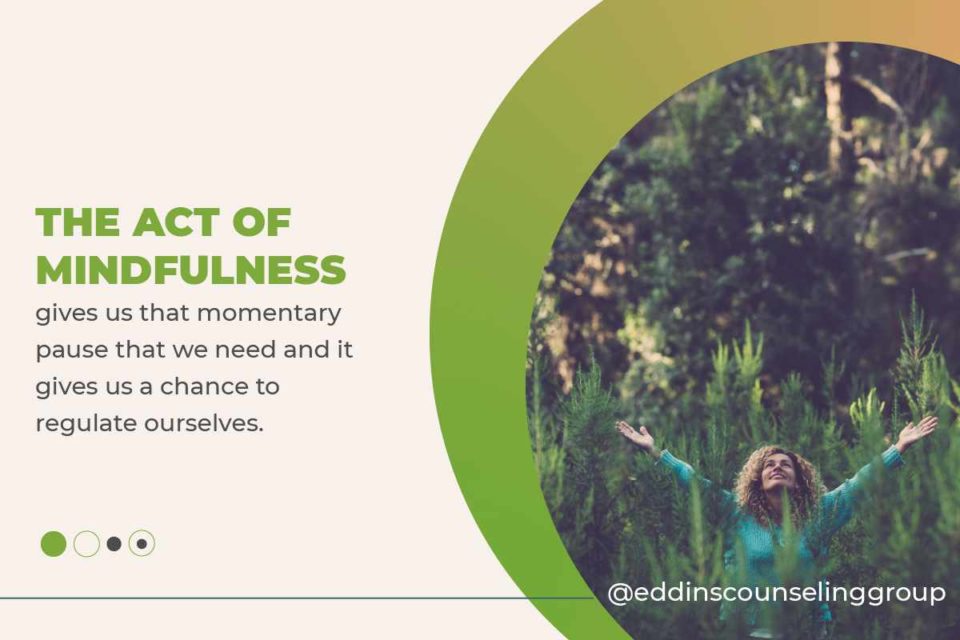
Mindfulness Helps Us Respond vs React
Something that my dad has always said to me from middle school very early on that’s always stuck with me is that “no one’s ever going to listen if you’re speaking from emotions rather than facts.” And that to me means that if you’re arguing with someone or you’re really upset or you’re trying to get your point across, if we’re so emotional that we can’t say what we actually want to say, no one’s ever going to be able to understand us.
So again, it comes back to mindfulness and taking that brain break so that we’re able to better present ourselves and better talk about things again. What this has to do with mindfulness is that the act of mindfulness gives us that momentary pause that we need and it gives us the chance to kind of regulate ourselves.

Example of Responding vs Reacting Using Mindfulness
Let’s use an example to explain a bit more. What if you’re walking into a bar and you see your significant other with someone else. Maybe your automatic reaction to your anger is to go punch the person, right?
We know that if we were in a more calm state, we might have responded a bit better. We might not have punched the person.
Say, maybe we walked in, we saw them and we saw that our significant other was cheating. Rather than going up and punching the person that they’re with, we walked out of the bar. We took a few moments and then we wanted to come back and respond to the situation. Now that you have slowed down and noticed your feelings with mindfulness, you might have reacted a bit differently.
And so then we’re responding a bit differently as well. When we’re more aware of what our current emotion is and we’re accepting it, they tend to not overwhelm us anymore. And so this can be used again when we’re angry.
This can be used during PTSD, flashbacks, and anxiety attacks. Really any situation that we just really feel like our emotions are getting the best of us and we need to just calm down. That’s what mindfulness is all about.
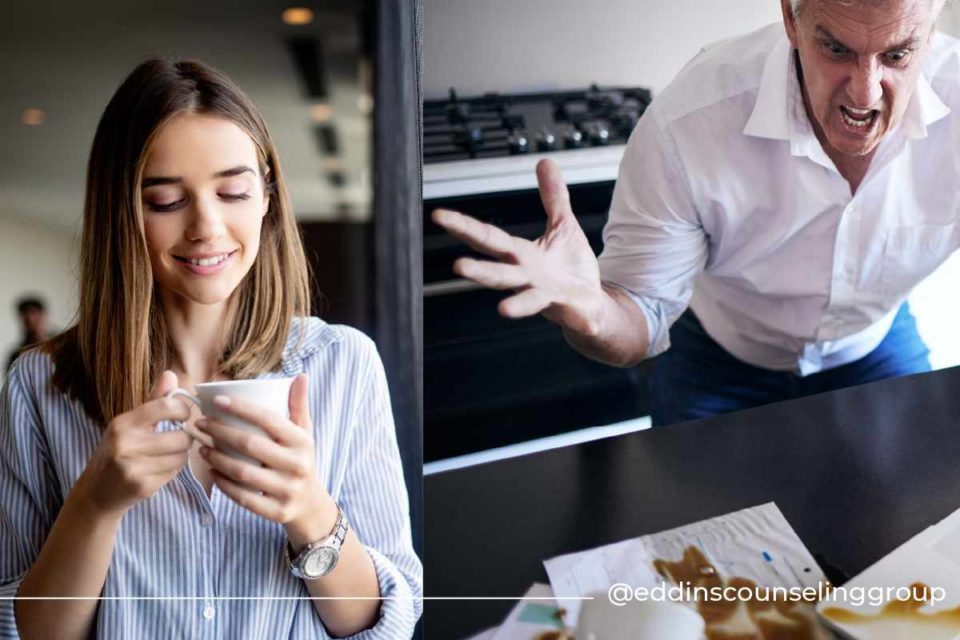
Setting Ourselves Up for Success
We’re going to walk through the steps and how we cultivate mindfulness rather than just using that term so vaguely. So I like to also think about this in terms of how we best set ourselves up for success.
Another analogy that I like to use with clients is whenever we’re waking up and say we wake up and we know that we have to leave the house at 09:00 a.m. So, we wake up at 07:00 a.m., we get ready, we have a really great morning, we are on time, and we get out the door, but we accidentally spill our coffee.
If we’re already in a regulated state, that might not make us as angry. However, if we woke up ten minutes before we have to get out of the door, we barely have even enough time to make our coffee. And so at that moment, we walk out the door and we slow our coffee and it’s like, oh, wow, this is going to be the worst day ever. So we’re so mad that we spilled our coffee because our day itself was already so frazzled and it was not setting ourselves up to be able to handle the daily stresses.
Mindfulness in the Morning
So doing mindfulness in the morning, and giving yourself that momentary pause sets your whole day up for success. It helps you handle your daily stressors a lot better than, say, waking up ten minutes before your alarm goes off.
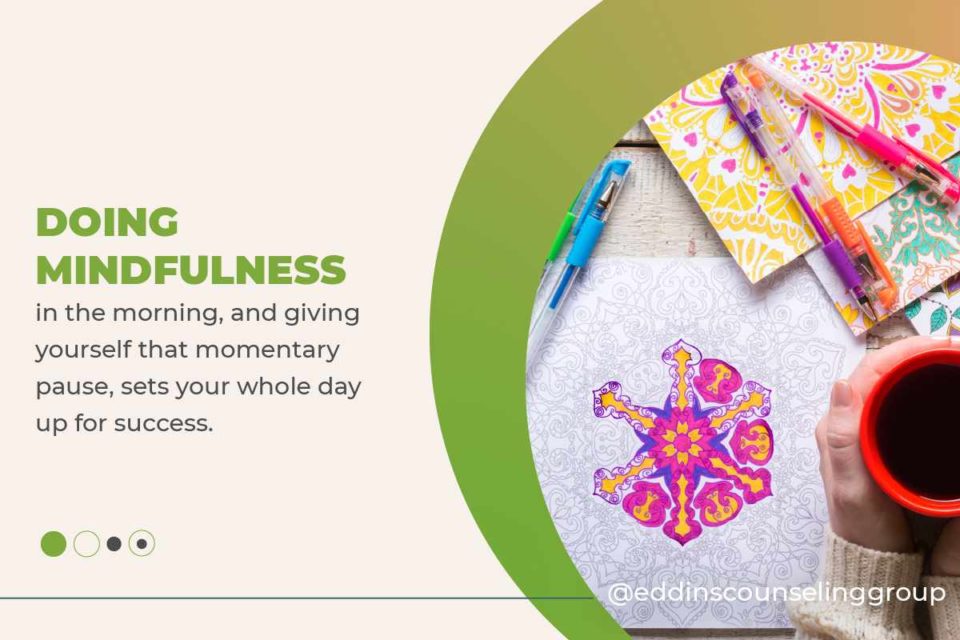
I have a lot of clients who come in with anxiety, and the first thing that we normally do is let’s set up a really good nighttime and morning routine because we want to set our days up for success and make sure we’re getting adequate sleep. I like to tell clients that sleep, food, and safety, like physical safety and mental health safety, are the plates that hold us up. If we’re putting more stuff on top of our plate and the plate is broken, we’re not going to get anywhere.
Mindfulness Helps to Build a Foundation for Mental Health
The plate that’s made up of accurate nutrition, good sleep, and safety is really what’s going to help you be able to handle your daily anxieties and your daily stresses. And when we’re talking with clients who are experiencing depression and they’re trying to get themselves up every day, that’s a struggle.

Sometimes it’s not even what the first concern is. The first concern is how do we stabilize that plate and that foundation of your life? So then we can tackle everything onto it. Mindfulness is really great at stabilizing that plate.
Using the example of whenever you’re really angry, you might say stuff that you regret, if we look at any two people. This doesn’t have to be romantic partners, it can be family members, siblings, parents, parents, and children. It can be friends, it can be teachers, it can be a therapist and a client. If anyone is getting into kind of a conversation where emotions are being heightened. We’re wanting to be able to respond rather than react at that moment. A lot of the time in couple therapy, we might say let’s create a safe word, let’s create a safe signal.
That safe signal or that safe word is okay for any person in that conversation to walk out without any repercussions. You can’t get mad at that person for leaving. You can’t get mad at them for needing a pause because that walk away and that pause hopefully will be used for mindfulness, to calm down, to regulate yourself so that you can come back to the conversation and feel like you have a better picture of things.
Adding Mindfulness to Your Day Can Decrease Stress
An example you can try is to give yourself some moments of mindfulness throughout your day. We want to be able to better handle the stress of what your daily life is, whether that be school or work.
Set a reminder on your phone at 1:30. Every single day we’re going to do five minutes of mindfulness and continue our day until 05:00 p.m.
This way, when you get home after work at the end of the day you will not have to shut down for hours and have a zombie’s brain. I’m sure that we all get that moment of trying to decompress after a really long day.
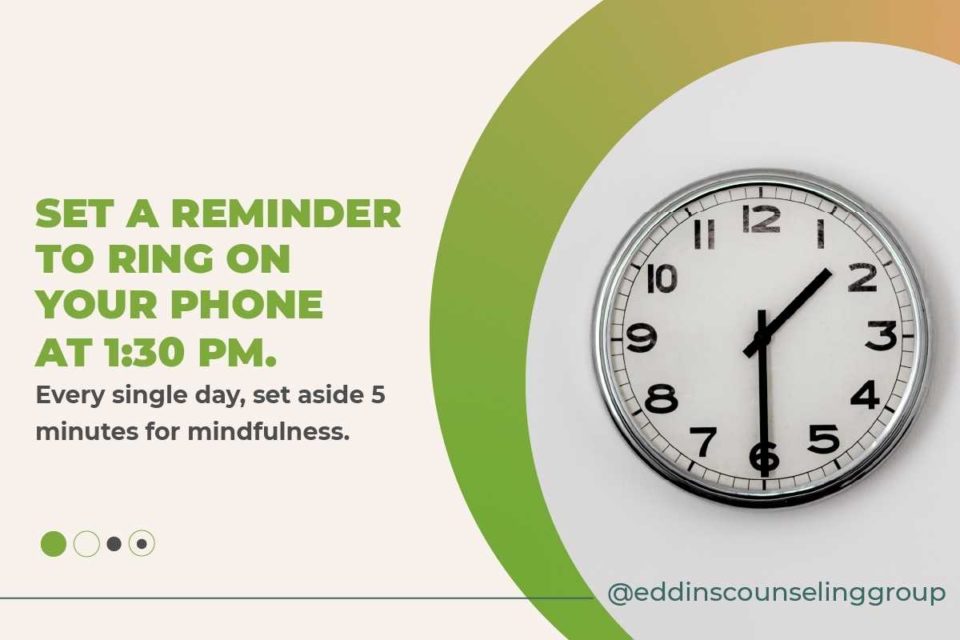
Mindfulness in Daily Activities
I think that everyone in these last couple of years, all of our schedules have been so thwarted and there’s been so much on the news and it’s like so much information and sometimes it’s too much information. I have one client who said that their mindfulness is not watching the news every day. If they want to know something, they’ll Google it rather than put something on TV.
The thing about mindfulness is that we can really make it whatever we want to make it.
And so just some of these examples. We can move on to kind of the nitty-gritty of when this can be most beneficial as well as, like, this example of this panic attack.
I know that a lot of people when they hear the term panic attack or anxiety attack, you automatically think of someone who’s hyperventilating. They can’t control their breath. In reality, it can be someone that has an upset stomach. It can be that sitting in a room full of people feeling like you’re alone. It can be that constant rumination of your thoughts. It can be the feeling of “I’m going to die”. Thoughts might include “I feel like I’m going crazy. I’m having a heart attack right now. My body is tingling.” It’s not always visible to the outside eye.
With mindfulness, you can make it whatever you want. We can really do it whenever. We can do it whenever and wherever. We can do it alone. We can do it in groups of people. We don’t need to buy anything for it. We don’t need to have anything special. You can just do it with your own body.
Who Can Use Mindfulness?
And so, who can use mindfulness? It’s adapted to fit all ages. A lot of the exercises that I do, I can do the same one, and I can do it with my adult clients. I can do it with my teenage clients. I can do it with my five-year-old. It’s really useful for teachers and students.
I have a couple of friends who are teachers, and they like to start their kindergarten classroom off with mindfulness. And that really just helps get the kids in gear for the rest of the day.
Clinicians can use this in-between client. Say you have a really heavy session and you feel dysregulated from all of the stuff that you just took on from your clients. Clinicians are people, too. And so our emotions can sometimes be really affected by our clients and what we’re talking about in the session that day. And so sometimes shutting my door after a really long session and just taking five minutes to do deep breathing to kind of make sure that what happened with that client is leaving with that client and not getting carried over into the next session can be really beneficial.

Mindfulness Can Help You Create Work-Life Balance
At the end of the day, usually, I like to do mindfulness before I get out of my car and go into my house because I don’t want to take work with me into my home life. And I think that anyone can relate to work-life balance, whether we’re a student or whether you’re in a career or whether you’re in the midst of both.
Sometimes it’s really hard to find that balance and mindfulness can be used in between those moments. When we’re trying to take off our work hat or our student hat, and we’re trying to put on our home life hat.
Mindfulness can be really good in those transitional moments. And really it can be used for anyone who’s wanting to be more in tune with themselves and with their own emotions.
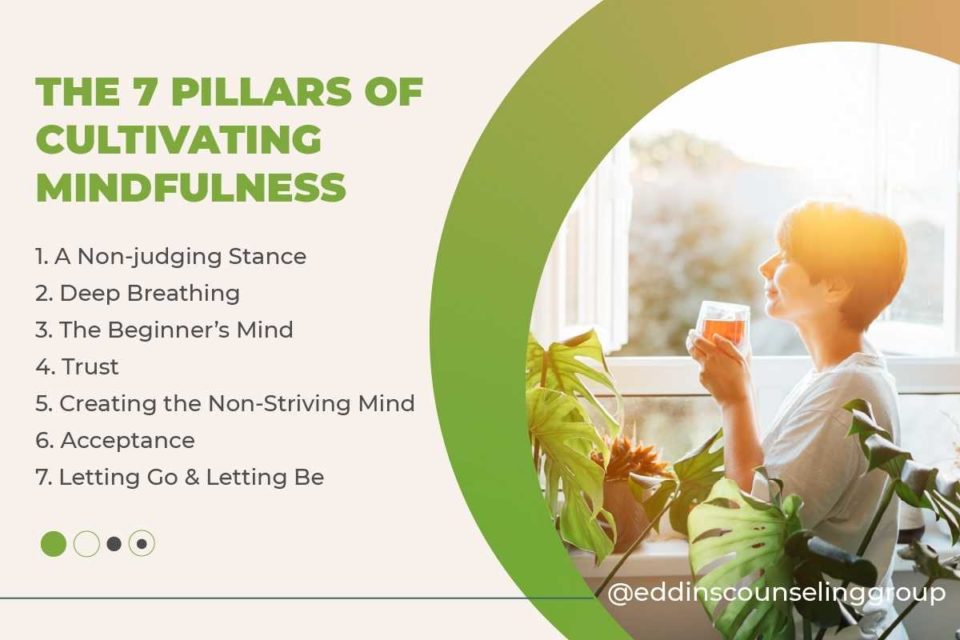
The 7 Pillars of Cultivating Mindfulness
I have clients who, due to trauma, have gone through so much in their life that they just report feeling numb. And it’s not that they’re actually not able to experience their emotions, but it’s that they’ve either been processed in the wrong way or responded to in the wrong way.
And so over time, they just learned to suppress them so much. And so mindfulness can sometimes really be used to help us learn more about our own emotions and what we need to respond to them versus reacting to them.
So, I like to think of these as a few pillars of cultivating mindfulness. We can sit here and we can say, let’s engage in some mindfulness all we want, but how do we actually partake in mindfulness? How do we actually set ourselves up for that?
1. A Non-Judging Stance
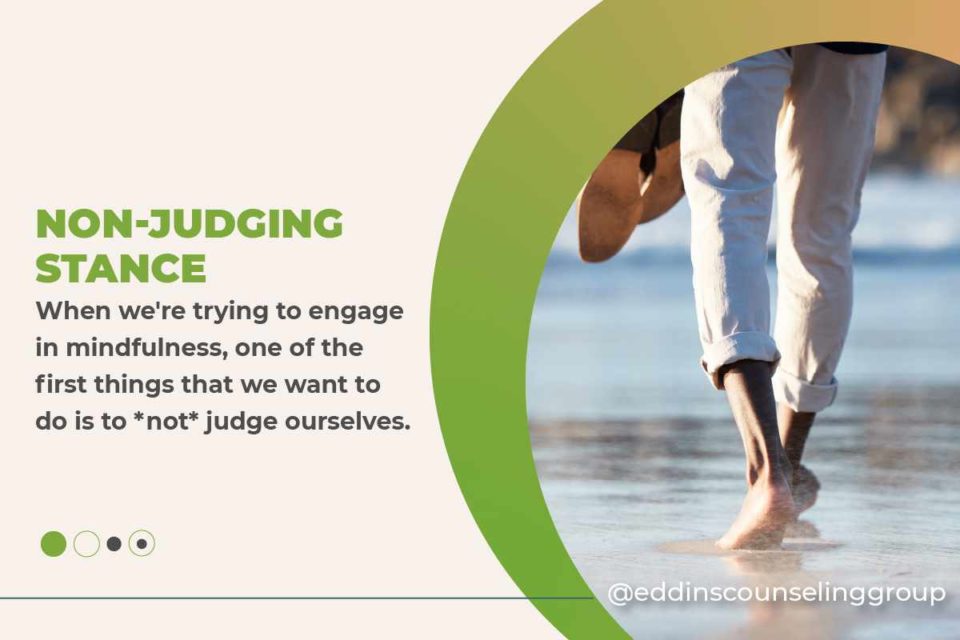
This means that we want to be impartial witnesses to our emotions in these moments. So, we all have that judgy brain. And I think that we’re all our own worst critics.
We tend to judge ourselves way more than anyone in our life will judge us. And because of that, when we’re experiencing a certain emotion, sometimes we tend to either write off what we’re feeling and tell ourselves that we’re being dramatic, or sometimes we tell ourselves that we’re not responding in the right way.
We should be responding differently. So when we’re trying to engage in mindfulness, one of the first things that we want to do is to not judge ourselves.
Try to look at the situation like a bystander. People talk about therapy and how it’s nice because the therapist is an impartial party. They’re non-bias in your life.
When we’re setting up mindfulness, you want to try to be your own therapist at that moment. You want to try to be an impartial party, and you want to try to be looking at the situation like you’re watching it on TV.
And so that’s whenever we’re trying to be the impartial witness to our own emotions and try to separate the experience of how we’re feeling versus what we’re actually trying to look at again, if we’re looking at it like we’re on TV, we’re trying to take ourselves out of the equation there.
And patience. Patience really is key with mindfulness. I tell clients all the time, let’s start small.
2. Deep Breathing
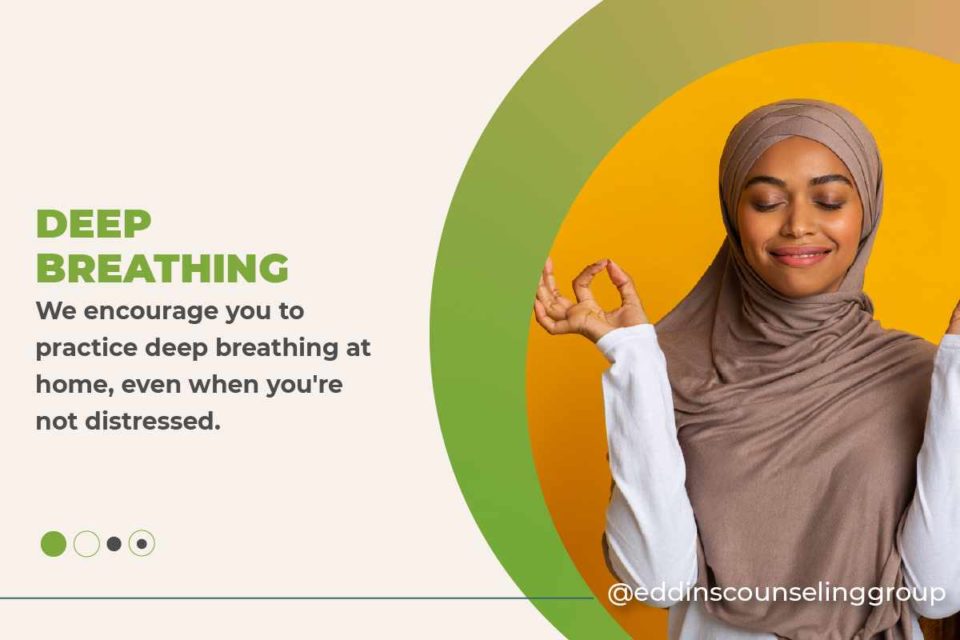
We are going to start with a minute of deep breathing because that minute of deep breathing for the first time is going to feel like five minutes have gone by because it really takes a while to be able to hone in on these skills.
I tell clients all the time. Don’t only do this whenever I’m in the room with you. Don’t only do this for the last five minutes of our session once a week. We encourage you to practice this at home, even if you’re not distressed.
That way, when you are distressed, these skills come so quickly to you. And so, again, patience is like the act of understanding that in their own time everything’s going to unfold. And it may not be how you’re picturing it, but we are trying to take the time necessary and the space necessary to create these practices for ourselves.
3. The Beginner’s Mind
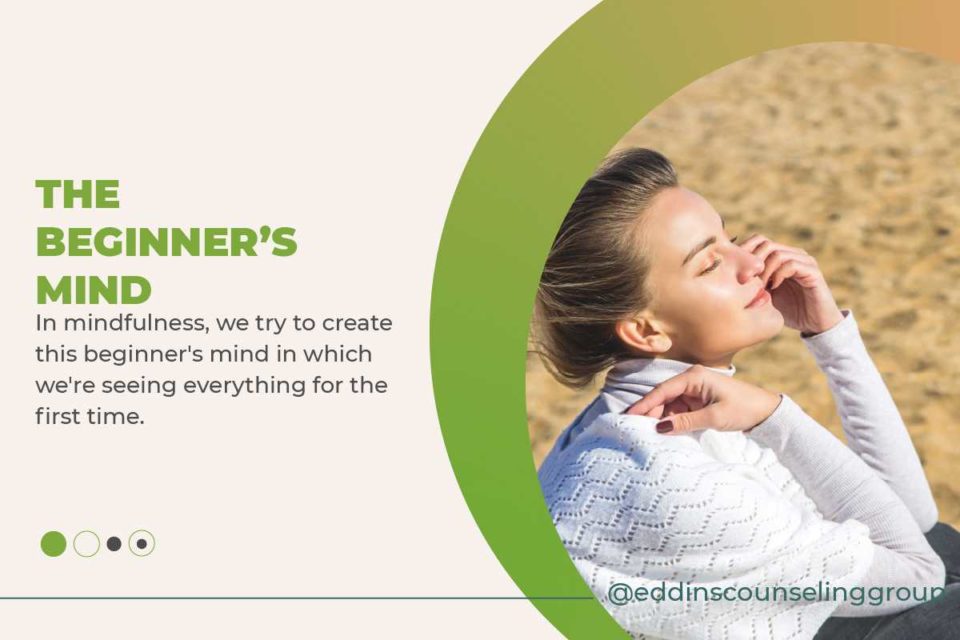
The third pillar here is the beginner’s mind. Sometimes we’re often blinded by our own emotions and how they’re attached to things. In mindfulness, we try to create this beginner’s mind in which we’re seeing everything for the first time.
We’re trying to separate ourselves from the equation, and we’re trying to look at it like it’s happening for the very first time without any preconceived notions of how we’re expecting it to go.
4. Trust

The fourth pillar is trust. So again, relating back to clients who talk about feeling numb, I don’t know how to experience my emotions. We’re trying with mindfulness to develop a trust in yourself and trust in your own emotions, not telling yourself I’m being dramatic, not telling myself I should be responding a different way, but trusting what your emotion is in that moment.
Because again, our emotions, sometimes tend to cloud our judgment of things. And it’s that aspect of are we reacting or are we responding to it?
So with mindfulness, we’re trying to trust our immediate emotions, and we’re trying to trust ourselves, and we’re trying to trust our feelings and our intuitions about things, and we’re trying to be open and receptive that these could be different from what actually is happening.
We’re trying to have a non-striving mind here too. Mindfulness takes a lot of work and energy, and a lot of patience.
5. Creating the Non-Striving Mind
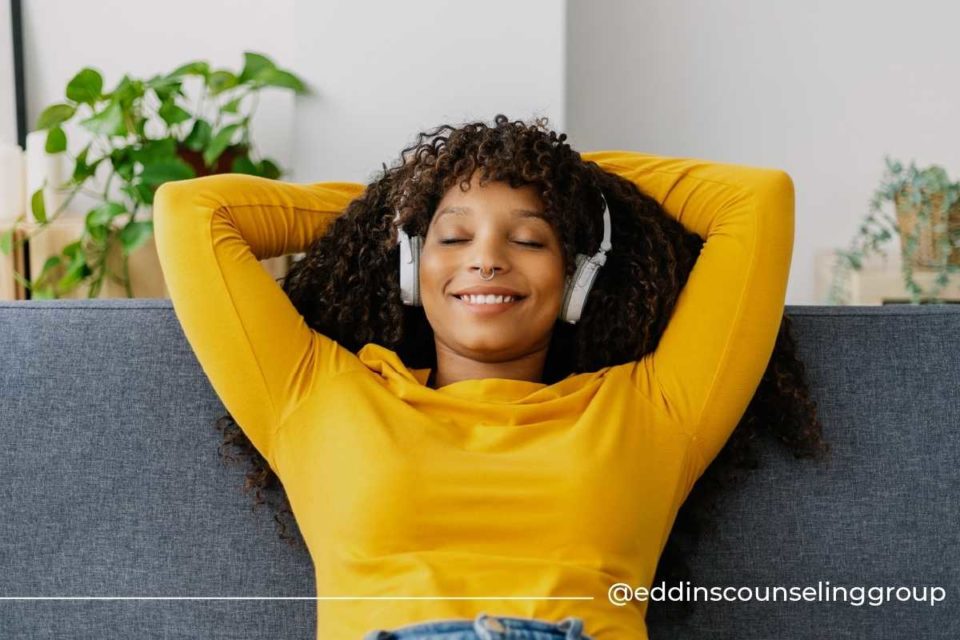
As human beings, we feel like we always have to be on the go. We feel like our schedule always has to be busy or we don’t feel like we’re doing anything. When we’re relaxing and we’re trying to have this non-striving mindset, we always tell ourselves, “if only I could relax”.
I feel like clients tell me all the time, I just don’t know how to relax. “If only I could relax”. But then when you’re focusing so much on relaxing, you’re not actually relaxing. You’re probably thinking about how much you should be doing in those moments.
So, with mindfulness, we’re trying to create that non-striving mind, and that’s not the same as no effort, because mindfulness does take effort, but it’s non-striving. You’re trying to let go of what you think the results should be.
If you think at the end of these five minutes you should be the most relaxed version of yourself that you’ve ever been. You’re not going to be the relaxed version of yourself that you’ve ever been in those five minutes because you’re going to be so focused on trying to relax, but you’re not ever going to relax.
So again, we’re trying to have that non-striving. It’s the “I have no intentions” kind of mindset.
6. Acceptance

The sixth pillar is acceptance. Mindfulness isn’t about telling yourself: “Everything good is going to happen.”
And part of this acceptance in this last one, letting go and letting be, is that we’re telling ourselves, “I accept my emotions, I accept that I feel anxious right now. I accept that I’m angry, I accept that I’m hurt, I accept that I’m depressed because that is my emotion.”
And no one can tell you what your emotions are other than yourself. And so when we start to accept our emotions, sometimes that leads us to be able to see them and not be afraid of them.
I have a client who told me that they were afraid to be sad because if they were sad, that meant that nothing would be good ever again. They were really judging that emotion of sadness. And so what we really worked on was that rather than telling yourself that you can’t be sad, let’s accept the sadness. Let’s try to work through it rather than push against it.
And that mindset was a game-changer for this client. It allowed them to feel sadness without feeling overtaken and like they couldn’t move through being sad.
So, whenever we learn to accept what our emotion is, we learn to accept that it’s there, but it’s not going to control us. I like to use the phrase, “just because you have anxiety doesn’t mean you are anxious.”You’re a person with anxiety, but anxiety is not who you are.”
Accepting & Acknowledging Feelings Helps Us Cope
Accepting and acknowledging that our feelings are there and being receptive to the feelings Whatever you’re thinking, whatever you’re feeling, whatever you’re saying, we know that we will have the strength to overcome it eventually, but we’re not going to let it overwhelm us and overcome us right now.
Learn more about recognizing your emotions.
7. Letting Go & Letting Be
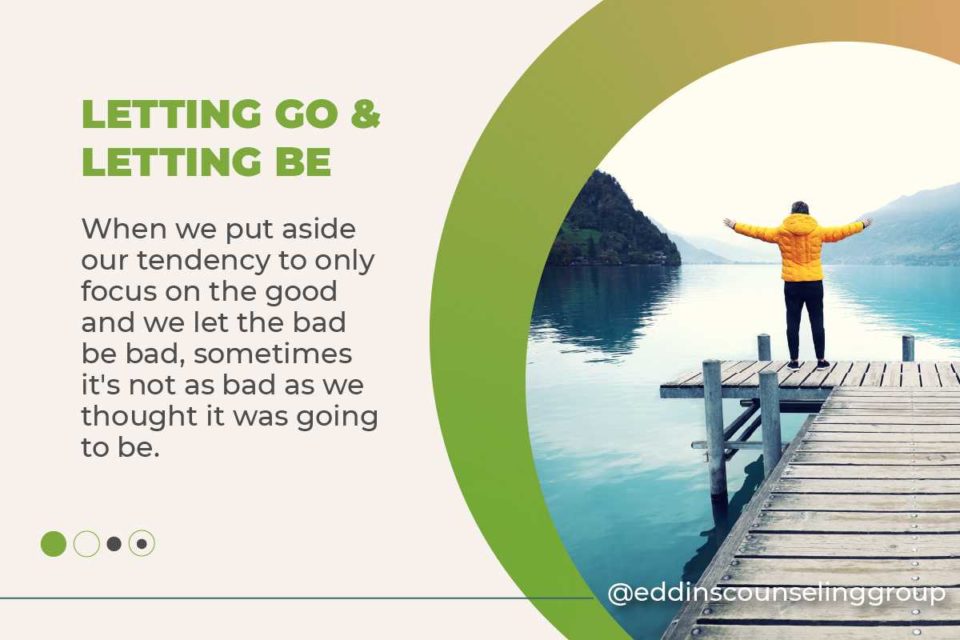
The last one of letting go and letting be is putting aside your tendency to only focus on the good.
I think that a lot of times when someone has something going on, someone’s automatic response is, what do you have good going on? Sometimes it’s not what anyone needs to hear. Sometimes you just need to hear, yeah, that really sucks. And I’m really sorry you’re going through that.
And so when we put away our tendency to only focus on the good and we let the bad be bad, sometimes it’s not as bad as we thought it was going to be. Sometimes when we accept that emotion and let it be what it is, it no longer feels like this dark black cloud that’s looming over us that’s never going to go away.
Those are the seven pillars that I like to start with when we’re trying to cultivate mindfulness.
- non-judging
- being patient
- trying to look at everything like you’re looking at it for the first time
- trusting your intuition
- trusting your feelings
- non-striving; no goals with this process
- accepting our emotions and letting them go and letting them be rather than again, trying to always change them.
How Do We Practice Mindfulness?
It’s taking a seat
It’s finding a place that’s really calm and quiet — sometimes it’s not always an option. And so I always like to ask clients, when would you most be using this?
- Would you be using this at work?
- Would you be using this at school?
- Would you be using it when you’re at the bar with your friends?
- Would you be using it on the subway?
Those aren’t places where you can sit and be quiet.
So, we can always learn. Again, what’s great about mindfulness is that we can make it how we want it.
We don’t always need that quiet space. And sometimes it’s just nice to learn mindfulness and the quiet because then you learn how to also take it and create it into what you need in your daily life.
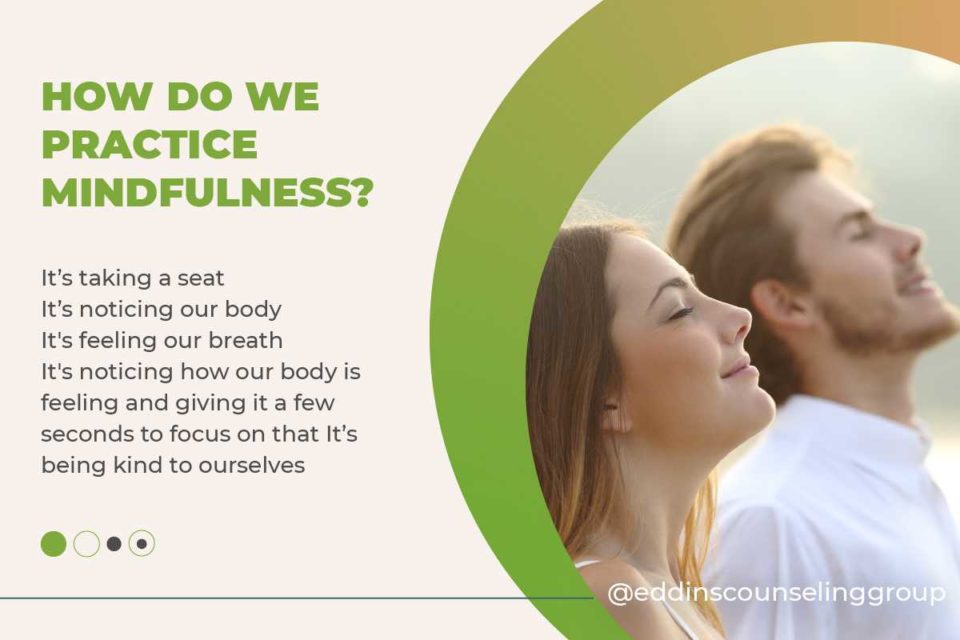
It’s noticing our body
So, it’s noticing, are you feeling really fidgety that day? It’s noticing how we’re sitting, are we comfortable? Do we feel tense? It’s just getting in a place. It’s going to be really comfortable for you. And again, we can do mindfulness standing up. We can do it sitting down. It’s going to be whatever is most comfortable.
It’s feeling our breath
A lot of guided meditation and guided mindfulness breathing will tell you, like, let’s notice how the air feels as it’s moving through your lungs.
- Is it cold?
- Is it warm?
- Is it short?
- Are you able to take a long breath?
When we start to feel our breath and mindfulness and deep breathing, usually we want a deep breath. And that stems from breathing from your stomach, not just your diaphragm, which to anyone who has not practiced deep breathing, that’s a really different way of breathing as well.
It’s noticing when our mind has wandered, because again, clients all the time, they’re like, oh, this is going to be so easy. But it’s not easy trying to kind of calm your mind down.
The goal of mindfulness isn’t to have a blank mind.
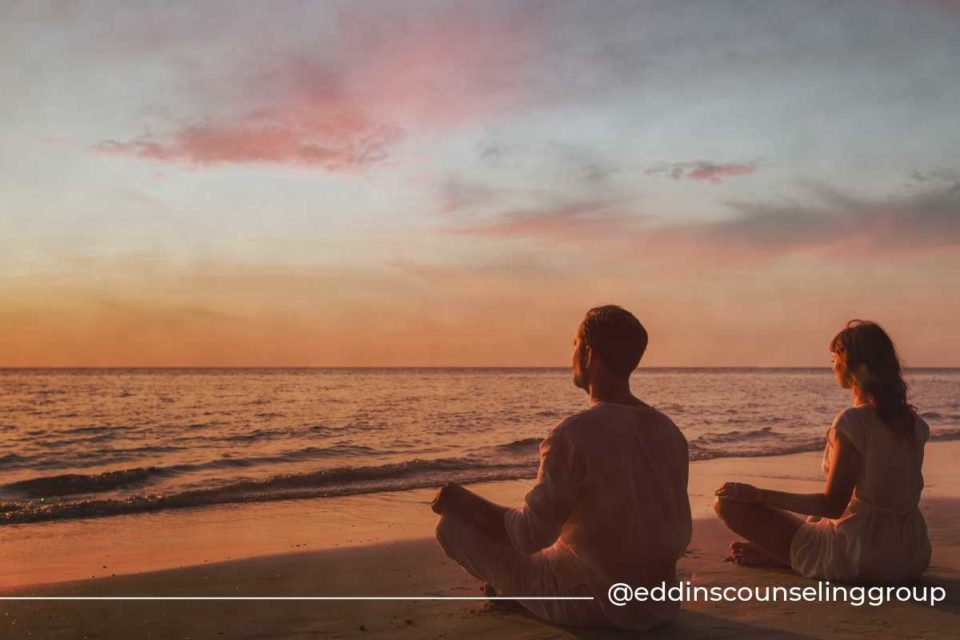
But again, back to those seven pillars. It’s learning how to not judge the thoughts as they come and the feelings as they come because your thoughts are going to wander. You’re going to get distracted by “Oh, my leg feels like it’s itching”.
The moment that we say we need to relax and not move. We’re going to want to move.
It’s noticing how our body is feeling and giving it a few seconds to focus on that.
And then we’re just going to want to bring our attention back to the task at hand, which is either going to be the deep breathing, the guided imagery, whatever that mindfulness practice is that you’re doing.
It’s being kind to ourselves
The last one is just to be kind to yourself and be kind to your wandering mind. Again, we’re trying to turn off that judgy brain, and we’re trying to really let ourselves be our own therapist, basically in the moments of mindfulness.
Examples of Mindfulness
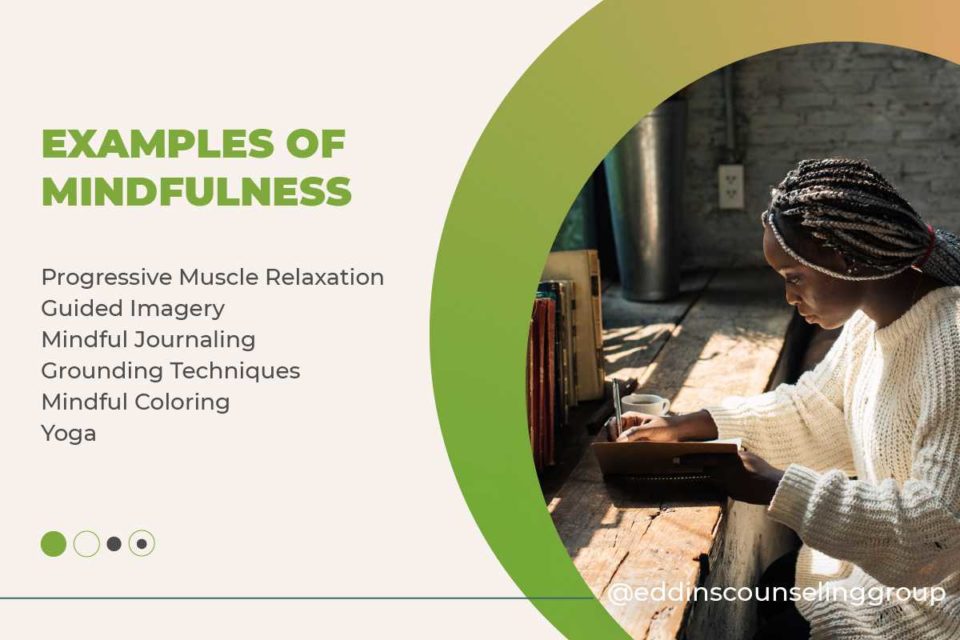
So, here are some examples of mindfulness. Because again, the thing that I love about this is that you really make it whatever you want it to be. You can turn anything into a mindfulness practice. It can be as simple as deep breathing. Or progressive muscle relaxation.
Progressive Muscle Relaxation
Progressive muscle relaxation is really great because it helps you be in tune with where you’re holding tension in your body.
And again, the mindfulness part of this is we’re trying to be in tune with our body and we’re trying to be in tune with our thoughts. And it’ll walk you through and it will tell you what a tense and where to release attention. And I love it because half the time when I do it, I don’t even realize that my jaw was so locked and so tense. And that’s where I was holding my anxiety that day.
Guided Imagery
Another example is guided imagery. There are tons of these. On the Calm app, you can walk yourself through guided imagery with Harry Styles or Robert Pattinson. You can go through a forest or a beach, kind of wherever you want.
There are multiple of these on YouTube and on the resources I included one that’s a forest and a beach. And these two are usually my clients’ favorites whenever I’m introducing them to a guided image tree.
Mindful Journaling
Another one is journaling, so we can do mindful journaling.
Again, this is part of what we’re wanting to create a non-judging mind. A lot of the time I have clients who are having ruminating thoughts that are constantly thought on repeat and repeat. How do we get it out of our heads? Let’s Journal it down. Let’s get it out of our heads and put it onto paper into words and not judge what’s there. You can keep it. You can rip it up later if you want. But we’re not going to judge the thoughts that are in our minds.
Grounding Techniques
There are grounding techniques such as something called the 5 4 3 2 1 technique that walks you through how to ground yourself in a panic attack, and how to ground yourself when you’re feeling really overwhelmed.
Whatever it may be that’s going on with your five senses. So it’s really nice because it’s using your body. You don’t need anything for this one.
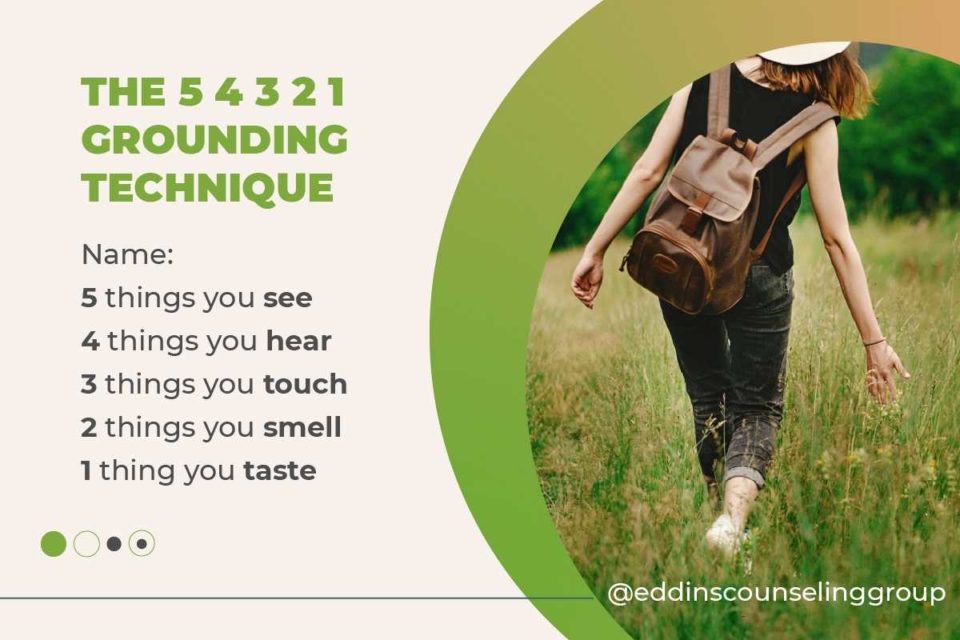
Mindful Coloring
We can do mindful coloring. I have an adult coloring book in my office that clients love to use whenever we’re talking. It helps them kind of keep their hands busy, but also it helps them have a more mindful conversation with me because they’re not focusing so much on what they’re saying, but they’re rather focusing on the drawing and then whatever spills out.
Yoga
Yoga is really a big practice of mindfulness. We don’t have to do yoga when we’re doing mindfulness, but we can be mindful while we’re doing yoga. We can go for mindful walks on YouTube. There are a lot of mindful walks, little snippets that you can listen to while you’re walking and they walk you through how to be mindful of the area around you.
Whenever we take what I like to call a mental health walk, sometimes it’s really hard to shut off our brains and not be focusing on everything that’s going on about our day. So mindful walking is nice because you’re listening to something which is distracting your mind. You’re getting somebody’s movement in, which is always great to help relieve stress.
And at that point too, it’s telling you what to focus on. And so if we’re having a really difficult time practicing the non-judging mind and not judging the fact that our minds wandering to other things, I like to use the walking one or even like listening to music while we’re practicing mindfulness and deep breathing because it’s giving your mind something to listen to and giving your mind that brain break while also giving your body something to do.
How to Create Mindfulness with Kids

Children have a much more difficult time focusing. If you have kids, or if you work with kids, these can be really great.
1. There is the hand. If you put your hand in front of you and you take an inhale and you trace your thumb and you go up and then you exhale and go down. I call it the hand breathing for little kids. The tactile sensation of touching their hand can calm them down while inhaling and exhaling.
When do you tell a kid to take a deep breath or like, what does that even mean? So you just inhale at the length of your fingers and then you exhale and it’s that again, that tactile sensation of touching their hand can calm them down, as well as help them learn how to control their breathing.
2. You can do square breathing. The video that I included a link to is a fish walking through how to do box breathing with little kids. And that one is basically you just make a box in the air. It’s inhaling at one side of the box and it’s exhaling and inhaling and exhaling and you’re just going around and they’re making a box in the air. And that one you can really make that one or whatever you want. You can do one big box. You can do a box inside of boxes. And again, it’s giving their hands something to do because they’re little and they need to feel fidgety and distracted, but then also teaching them how to control their breath while they’re fidgeting and while they’re moving around.
So, what I would like to do is practice. This mindfulness can basically take as long as we wanted to, and it can be as short as you needed to.
Here’s another mindfulness activity you can do with kids.
Let’s practice mindfulness
I had the honor of working with my professor and my supervisor for my internship in my grad school. Her name is Erin Martinez. And this one is completely hers. I’m not sure if she made it herself or if she adapted it, but it’s something that I’ve really taken with me and that I really enjoy doing with clients. It’s a form of guided imagery.
And what’s really nice is that this one specifically is really great for those who have experienced trauma. It’s really great to use if you’re working with a client with who you just talked about something that was very traumatic or even if you’re sitting at home.
And I told clients before, if you’re experiencing really traumatic thoughts, you can’t get out of it. You feel unsafe. Let’s practice this mindfulness. Let’s practice it outside obsession. So this isn’t just something that a clinician can teach a client, but also something a client can do on their own at home. It’s something that anyone with thoughts that make them feel unsafe can do so.
We know with those who experience PTSD flashbacks, our memories a lot of the time tend to make us feel unsafe when we’re remembering something really negative that happens, whether that be trauma or a conversation or any kind of memory that brings you to stress.
Sometimes we tend to forget that we’re still physically safe. So that memory is in the past and it’s not going to hurt us right now. But again, the memory makes it feel like it does. And that’s why you have instances of someone who is going through a PTSD flashback and they’re not aware of their surroundings. And so they might hurt someone around them, not because they mean to you, but because that memory felt so unsafe that they felt right back where they were when they were experiencing that trauma.
I don’t know if anyone watches Grey’s Anatomy, but Owen Hunt, one of the main characters on the show, had this episode where he was experiencing a PTSD flashback and he was lying with his girlfriend and he attacked her. He didn’t mean to, but at that moment, his mind put him right back to where he was. This safe place of mindfulness that I’m about to walk us through is really great.
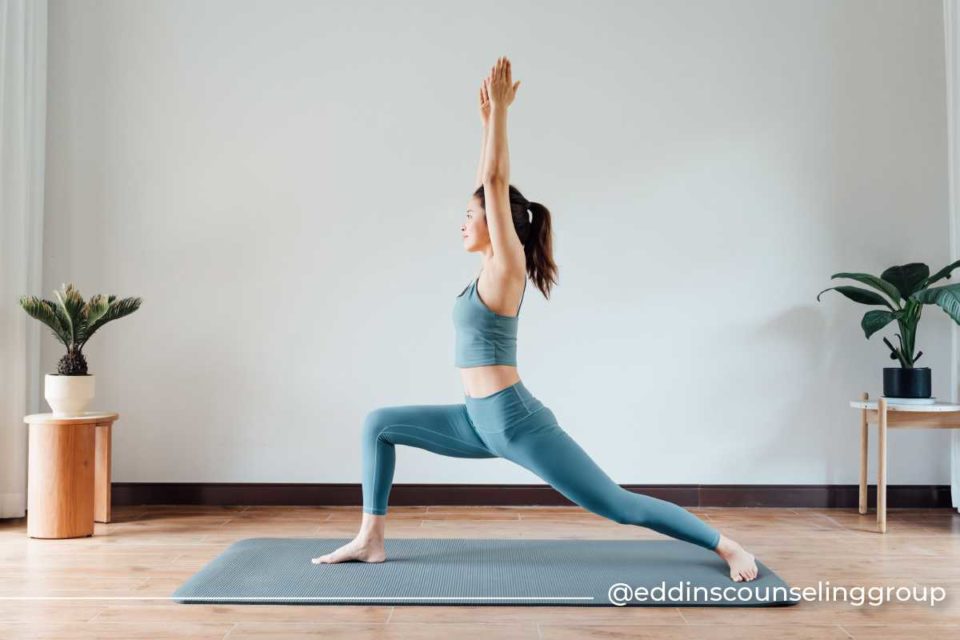
Guided Mindfulness Exercise
We’re not going to judge our mind if it wanders. We’re going to be kind to ourselves. We are not going to strive to relax right now. We’re just going to listen to the words and try to participate the best that we can.
Audio of mindfulness exercise.
https://youtu.be/A97hEY87rfg?start=2200&end=2426
So with that being said, if everyone wants to get as comfortable as they can wherever they are, you can either close your eyes or rest them where it’s going to feel comfortable for you.
And I want us to take three deep breaths and again, we’re going to breathe from our stomach, not just our chest, while we’re breathing. Now, I want us to imagine a safe place, whether this is somewhere that you’ve been in your life. Maybe it’s your favorite childhood memory. Maybe it’s somewhere you’re going to create on your own.
I want you to really imagine that place if you’re at a beach, what does the stand feel like beneath your toes? Can you smell the salt in the air? Can you hear the waves?
Really picture the textures and the sounds and the colors of your safe place. If we’re sitting down someplace in our safe place, is it comfortable? Are you alone there? Did you bring someone else into your safe place with you really build this up in your mind?
Let’s Get You into a Safe Place
I want you to now create a dresser in your safe place. It’s going to look a little weird if we’re at a beach, but let’s just put a dresser there. In the top drawer of that dresser is anything that we’ve talked about today. Whatever memory we’re holding on to, we’re in a safe place, and we see that this negative memory is there and it’s not going to hurt us.
I want you to now also picture a container. It’s going to be a box. It can be a jar. Maybe it’s a giant pool. We’re going to open up that drawer, we’re going to take all of those negative memories that we’ve talked about today. We’re going to put it into this container, we’re going to put a lid on it. We’re now looking at these negative memories, and they don’t make us feel safe in our minds, but physically they cannot hurt us right now.
I’m going to walk up and I’m going to take that container from you, and I’m going to walk away with it. We don’t have to think about these today for the rest of the day if we don’t want to. They cannot hurt you. We don’t have to talk about them again until we meet next time. Now the dresser is gone, the container is gone, the negative memories are gone, and all you’re left with is your safe place.
And I want us to spend a few more moments here really breathing in the safety that you feel. Whenever you’re ready, you can open up your eyes and rejoin me.
So, the thing that I really like about this is that it’s really great again to be used for those who are experiencing trauma because we know that in order to talk about trauma, we have to feel physically safe and we have to trust the person and feel safe with the person that we’re talking about it with.
And if we’re alone and we’re practicing the safe place meditation, I like to insert myself into the safe place and take away the negative memories so that when my clients practice it on their own, they can imagine me taking away their negative memories, and they don’t have to talk about them again until they’re with their safe person.
Adapting the Mindfulness Exercise

I’ve had clients take this a step further, and their container was a Mason jar, and they went and bought a Mason jar. And anytime they had a traumatic memory pop up or something negative happened throughout the day that they were too overwhelmed to handle, they’ve written it down and put it in that jar and brought it with them to a session for us to talk about then. So, you can really adapt this however you want and we can spend as long as we need to.
I tell clients all the time if you’re starting to feel really overwhelmed with your thoughts, with a traumatic memory, if you’re not a clinician, a way to practice this is to in your own life. We can practice it on our own. And just imagine your favorite person in the world being in that safe place with you and taking away those negative memories and not acknowledging them and talking about them.
Because we know we don’t ever want to fully repress negative memories. We know they don’t actually ever go away. But it’s okay to not talk about them and to not think about them until you feel safe to do so. And the safe place helps us acknowledge that while these memories aren’t that great, they cannot physically hurt me right here. That is all that I have material-wise. But I wanted to open up the floor.
How do you practice mindfulness if you feel yourself getting upset?
One thing that we know about mindfulness is that it’s not always as easy as we think that it might be. It’s really beneficial to you even when you’re not feeling upset. Say you’re sitting at work and you don’t have anything to do or you have a five-minute break.
Let’s practice a mindfulness technique when we’re feeling regulated and calm. That way, when we are feeling upset, it’s easier to grab those tools from our box. And so a way to practice if we feel ourselves getting upset is to try to take that judgy brain away and not judge yourself for feeling upset and just ask yourself like, what do I need right now?
Sometimes we’re not always going to need deep breathing. Sometimes we’re not always going to need progressive muscle relaxation or guided imagery. And it’s trying to learn how to be in tune with your emotions so that you know what you need at that moment.
So there’s no easy answer to how do we use it?
Because one thing that I always tell clients is that I can give them all these tools, but it’s up to them to use them outside of the session. It’s up to each of us whenever we’re learning these things, to practice them daily and to learn how to use them. Another question is, what age do you think I can help my child be mindful? This can start as early as three years old.
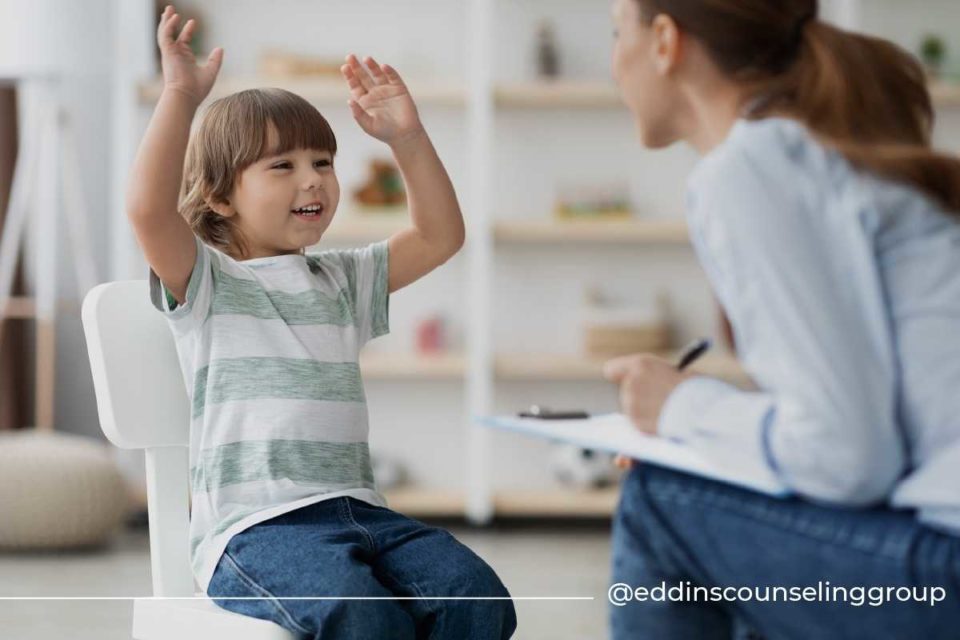
Learn How to Help Your Child
If we’re having a child with separation anxiety, one thing that we can do is help them learn how to regulate their breathing. We can do that through the yarn stimulation, through the box breathing. One thing I had a little cousin of mine, they were in a car accident with their mom. And they were terrified of going on the highway. They were terrified of the rain. So we were practicing mindfulness in the car while the car is parked in the driveway. That way they feel more regulated in the car. And then we’re going to be reintroducing that as it’s raining, as it’s storming, as they’re driving. So mindfulness, again, I love because it can be adapted for any age.
What is the best way to get rid of a monkey’s mind?
Monkey mind means a wandering or a fidgety mind. But the monkey mind, for me is to not judge ourselves as we’re wandering, because if we’re just sitting here and not doing anything, it’s only human nature to be thinking about everything else that we should be doing that day. And so, one way to do that is to practice the concept of not judging our emotions and our thoughts as they come at us. And it can be as simple as, yeah, while I’m sitting here and I’m trying to do progressive muscle relaxation. But I know that I have ten other things that I should be doing that day.
Try to take that “should” word out of your vocabulary and stop telling yourself what you should be doing at that moment.
Just do what you need, if we’re trying to practice mindfulness and experiencing the monkey minds, we’re most likely at that moment really needing five minutes of relaxation because that can help you better handle the rest of your day.
And so whether that’s just saying they’re like, OK, I know that I’m just going to give myself these five minutes because I deserve it. If I’m thinking about that argument that I had earlier with a friend, or if I’m thinking about the fact that I need to go make dinner for my kids, or if I’m thinking about all of these notes, all this work that I have to be doing, if I should be studying right now, I want to tell myself, yeah, like that’s a lot that I need to be doing.
I’m not going to be able to handle that if I’m feeling so dysregulated and overwhelmed, because if we think about an eight-hour workday. None of us are working for 8 hours straight. And when we learn how to use mindfulness to also help us manage our time a bit better and tell ourselves like, yeah, I have an hour of work. I know that I’m not going to be working for an hour, but how can I be most productive if I’m so overwhelmed about my day and that hour? I’m most likely going to tune out the rest of my day. I’m going to zone out and I’m not actually going to be working. So just kind of telling yourself like, I deserve these five minutes because these five minutes are going to help me be more productive.

Conclusion
What’s really nice about the beginners’ videos for deep breathing is that it’s teaching you the skills. And if you notice the circle was getting bigger and bigger to show you how to practice taking deeper and deeper breaths. You always want to kind of hold it and then release the breath. And there are other videos after we’re learning how to do the deep breathing and the controlled breathing, that’s like the foundation and we can add on top of that, and then that’s whenever we can add let’s try to bring our attention back to the task at hand.
Let’s try to not let our thoughts wander. But again this right here is a really great video to teach you just the basic practice of deep breathing consistently because we can all take a really deep breath as the doctor tells me, just take one deep breath for me. But to be practicing deep breathing for a minute to two to three to five minutes takes practice and this circle that gets bigger and bigger for a deeper and deeper breath is really nice.
At Eddins Counseling Group, we offer Mindfulness Therapy. We offer in-person therapy in three locations: Houston Heights, Houston Montrose, and Sugar Land. We also offer online therapy. Learn more about it today!
Why You Feel This Way
Get instant access to your free ebook.
Grounding & Self Soothing
Get instant access to your free ebook.
7 Mood-Boosting Tips
Get instant access to your free ebook.

